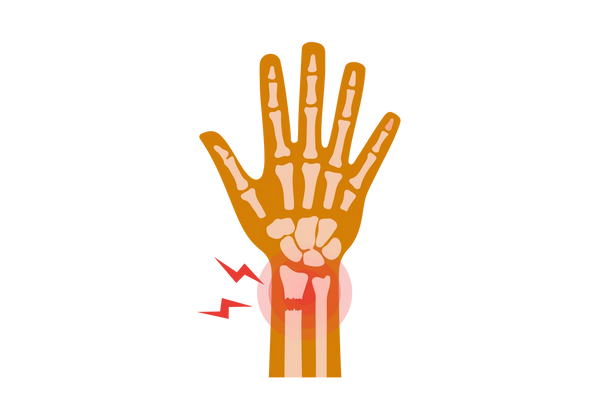What is a wrist fracture?
There are eight small bones (called the scaphoid) in your wrist, which connect your hand to your forearm. A wrist fracture is a break in any of those bones or at the end of either of your two forearm bones.
The most common kind of broken wrist is a distal radius fracture. That's when you break the long bone in your forearm (radius) near the wrist.
Wrist fractures are caused by impact, like when you fall onto your outstretched hand. Most fractures need a cast or a splint. If it’s a severe break, you might need surgery.
How do you know if you fractured your wrist?
Pro Tip
The scaphoid fracture—the most common small bone in the wrist to be fractured. —Dr. Bradley Graw
If you fractured your wrist, you’ll feel or see the following symptoms:
- Pain around your wrist, hand, and forearm.
- Swelling in the area.
- Less range of motion than normal (the amount you can move at the joint).
- Pain in the wrist when you move.
Other symptoms you may have
If you have a severe fracture, your wrist or arm might cause a visible deformity of your bones. A severe fracture could also injure the nerves or blood vessels, which will make your wrist or arm feel numb, weaker than normal, or have less blood circulation.
Risk factors for wrist fractures
Dr. Rx
People often think it’s just older people who fracture their wrist. Not true! It happens to young active people and athletes after falling on an outstretched hand. In some cases, these injuries can be quite impactful. —Dr. Graw
The risk of wrist fracture is higher in women than in men. This is partly due to differences in bone density, bone size, and bone strength between men and women. Older adults are also most likely to get a fracture. Smoking, drinking alcohol, and taking steroids can also increase your risk of bone fractures.
Most people fracture their wrist from a fall. People who have issues with balance—like the elderly or those with certain neurological conditions—are more likely to get a fracture.
Certain sports put you at risk of wrist fractures, including snowboarding, inline skating, and biking.
Also, certain medical problems can make your bones weaker. These conditions include rheumatoid arthritis, celiac disease, inflammatory bowel disease, and diabetes.
Next steps
If you think you broke your wrist, go to an urgent care, emergency room, or hand surgeon.
Signs of severe fracture are:
- Damage you can see (visible deformity).
- If you can see bone coming through the skin.
- If your hand feels numb or weak.
- If any part of your arm is swelling quickly.
- If your hand looks pale.
Pro Tip
Most wrist fractures do not require surgery. Although you may have to be immobilized for a period of time to get the bones to heal. If you do need surgery, the goal is to align the fractured bone or joint so that you do not eventually get arthritis. —Dr. Graw
Wrist fracture treatment
Sometimes a fracture can be diagnosed from a physical exam but most fractures need to be diagnosed with an X-ray, CT scan, or MRI. Mild fractures will need a splint or cast. Pain can be controlled with over-the-counter pain medications.
If you have a severe fracture and the bones are misaligned, you may need to be sedated in the emergency room so that the doctor can move them back into place. After the procedure, the doctor will place a cast on your wrist. The most severe fractures may need surgery.
Medications
While your wrist is healing, it will still hurt. You can take over-the-counter pain medications like acetaminophen (Tylenol) or ibuprofen (Motrin). If the pain is really bad, tell your doctor. They might give you a short course of narcotic pain medication, like hydrocodone or oxycodone.
Procedures
Most fractures just need a cast or splint. Some fractures need to be realigned before they are casted. The ER doctor will give you pain and/or anti-anxiety medication. Then the bones are pushed back into place.
Severe fractures, such as when broken bones stick through your skin, will need surgery. This is called “open reduction and internal fixation.” Metal plates are screwed into the bone to help hold the broken pieces in place so the fracture can heal properly. In some cases, the break may not heal completely or the fracture affects the blood supply to the bone. If that happens, you might need another surgery to fix it.
Ready to treat your wrist fracture?
We show you only the best treatments for your condition and symptoms—all vetted by our medical team. And when you’re not sure what’s wrong, Buoy can guide you in the right direction.See all treatment optionsFollow up
Most breaks take about 8 weeks to heal. Severe fractures, and those that require surgery, can take up to 6 months to heal and for you to regain the normal use of your wrist.
If you get a cast or splint, you need to follow up with a doctor in 1 to 2 weeks. They’ll check how it’s healing and might order another X-ray. If you had surgery, you will have several follow-up visits with your surgeon to make sure that your wrist is healing well. You may be referred for occupational therapy or hand therapy while your hand is healing to help regain strength and movement.
Preventative tips
- When playing sports or exercising that have a risk of falls, like rollerblading and snowboarding, wear wrist guards.
- For the elderly or others who are at higher risk for falling, work with a physical or occupational therapist to fall-proof your home.
- If you have a condition that makes your bones weaker, talk to your doctor. They can give you a diet plan and medication that will help keep your bones healthy.
- Avoid drinking too much and quit smoking if you smoke.
Was this article helpful?
